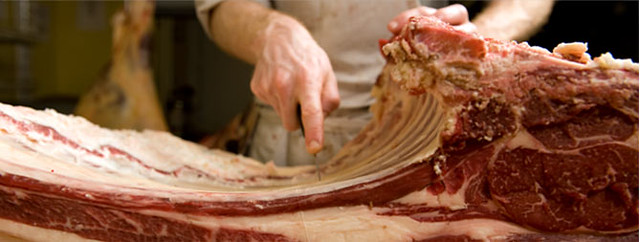
Today we’re going to address a question people frequently ask about Fleisher’s: Is our beef Prime?
The short answer is no. But in order to understand the answer, you have to know what the question really means.
First things first: While all meat sold in this country must be inspected by the United States Department of Agriculture, it does not have to be USDA graded — that’s an optional program. The big meat operators tend to have their meat graded, so they can use the top grades as marketing tools. Most of the Prime-graded beef goes to high-end steakhouses; the next two grades, Choice and Select, are what you typically find in supermarkets (although you’ll almost never see a supermarket, or anyone else, bragging about Select-grade beef).
But here’s the thing: The USDA grading system is primarily based on the amount of intramuscular fat, or marbling, in a beef carcass. The greater the marbling, the higher the grade. (You’ve probably heard about and maybe tasted Kobe or Wagyu beef, right? The reason it’s so highly prized is that it has an insane amount of marbling — so much that it sometimes looks like fat streaked with meat, instead of the other way around.)
Now, if you’re dealing with grain-fed, feedlot-raised steers — in other words, factory beef — marbling isn’t a bad gauge of quality. A Prime-graded feedlot steak usually does taste better than a Select-graded one. And that’s fine, as far as it goes.

But we don’t sell that kind of beef. Our steers eat grass and roam around in the pasture. They don’t pack on as much fat as their grain-fed cousins, and then they work some of it off because they’re outside, getting exercise. So if you look at the steaks in our display cases, you won’t see a whole lot of marbling. That’s why most producers of pasture-raised beef, ourselves included, don’t bother with grading, because the grading system is designed to measure something our beef doesn’t have, or even strive for. Subjecting one of our beef carcasses to USDA grading would be like judging a great author on the basis of his tennis game.
But that doesn’t mean our beef doesn’t taste every bit as good as Prime-graded beef. Frankly, we think it tastes a lot better. Pastured beef has a fuller, more complex flavor than grain-fed beef. Part of it is because of the animal’s diet, and part of it is that you’re actually tasting the meat, not the fat marbling. Try it for yourself — you’ll see.
We understand that a lot of people instinctively look for marbling, and that even more people automatically perk up when they hear the word “Prime.” But we’re not out to sell Prime-graded beef; we’re out to sell the best, most flavorful beef. We believe we’re succeeding — and once you taste our beef, you’ll know it too.
(One footnote: There’s no relation between Prime-graded beef and the term prime rib, which is another term for a standing rib roast. Any grade of beef can be used for prime rib. In other words, you can make — and some restaurants definitely serve — Select-grade prime rib. Or course, you can also make prime rib from pastured beef, like ours. And it’s the bomb.)